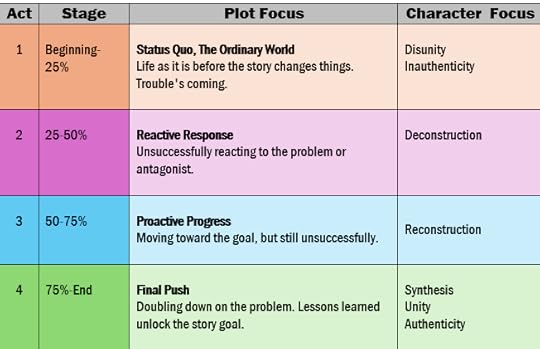The Ripple Effect: How to Weave Plot with Character

Actions have consequences���that���s what makes a story tick. A story begins when events around a character push them into action. Those actions create new situations, and those situations push the character into even tougher choices. Watching this chain reaction unfold is what keeps readers glued to the pages.
When we call a story “entertaining,” we���re really talking about something deeper: the chance to step into someone else���s experience. We want to understand their choices and see how their decisions mirror our own journey.
We���re not reading strictly to find out what happens, but neither are we reading only to understand why. Instead, we���re fascinated by the ripple effect of how one dynamic feeds the other.
A satisfying story does two things at once. It sweeps us into an absorbing plot while simultaneously easing us into the vicarious experience of a character���s inner transformation. Plot events shape the character���s options, and their choices then create new situations���a self-perpetuating cycle of action and reaction that creates the story.
Are stories plot-based, or are they character-based? The answer is yes.
Story is the synthesis of both. Plot shapes characters, and characters drive plot. Stories draw their power from the interplay between the two.
Here���s how plot and character organically wind together in classic Western storytelling, act by act.
Act 1: Welcome to the Ordinary WorldKey ConceptsAct 1: The first quarter of the story
Plot Keywords: status quo, the normal world, the ordinary world
Character Keywords: disunity, inauthenticity
The story opens on a character living in disunity and inauthenticity, although they don���t realize that yet. Something about their life is lacking, internally or externally or both.
The first act introduces the character, builds the story world and its time, place, and rules, and plants the seeds of change. This sets the chain of action and reaction that drives everything to come, creating the plot that the character will spend the rest of the story pursuing and wrestling with.
Act 1: This act is a story about how inauthenticity and disunity arrive in this character���s life.
Turning Point 1 (end of Act 1): This is how the character resolves to fix the problem created by inauthenticity or disunity.
Act 2: The Easy Way OutKey ConceptsAct 2: The second quarter of the story from 25% to 50%; in three-act structure, this is the first half of Act 2, the part before the midpoint
Plot Keywords: reactive response, the easy way
Character Keywords: deconstruction
The character steps into this quarter of the story ready to tackle their problem, but they’re going about it all wrong. They’re reacting to their new reality without truly understanding it, chasing solutions that look promising but won’t really work. They’re still operating from old patterns and incomplete understanding.
This initial approach begins to crumble as they discover the problem runs deeper than they thought. Their responses slowly deconstruct their familiar worldview, forcing them to question what they believe about themselves and their situation.
Act 2: This act is a story about how the character reactively responds to the problem.
TP2 (end of Act 2���the midpoint): This is the moment the character realizes their reactive response isn’t working. The problem has grown more complex than they imagined, their old worldviews are deconstructing piece by piece, and they must find a new path forward.
Act 3: The Hard RoadKey ConceptsAct 3: The third quarter of the story from 50% to 75%; in three-act structure, this is the second half of Act 2, the part after the midpoint
Plot Keywords: proactive progress, the hard way
Character Keywords: reconstruction

The character enters this act with a new understanding: It’s time to stop reacting and time to start acting. They begin approaching their problem head-on, using newfound tools or information or wisdom, but success doesn’t come easily. The obstacles they face grow to match their increasing capacity.
As they make proactive progress toward their goal, they gradually reconstruct a new worldview to replace what was torn down. But this reconstruction comes at a cost���each step forward requires more from them than the last.
Act 3: This act is a story about how the character makes proactive progress toward solving their problem.
TP3 (end of Act 3): This is the moment when the character’s proactive approach seems to fail despite everything they’ve learned. Though they’ve been reconstructing a stronger sense of self, they hit what appears to be an insurmountable obstacle or dead end.
Act 4: Bringing It All TogetherKey ConceptsAct 4: The final quarter of the story, from 75% to the end
Plot Keywords: final push, climax, resolution
Character Keywords: synthesis, unity, authenticity
This is where all threads converge. The character faces their goal and whatever stands in their way, and now they’re armed with something new: authenticity. The climactic breakthrough isn’t just about solving the external problem���it’s about achieving unity between who they are and who they need to be.
Act 4: This act is a story about how the character achieves synthesis, finding their authentic self and moving forward with a new sense of unity.
Climax: This is the moment when the character’s newfound authenticity or unity enables them to solve their problem in a way that would have been impossible before their transformation.
 Finding Your Story���s Flow
Finding Your Story���s FlowEach story finds its own rhythm within the cycle of these four acts. Stray too far from their natural flow, though, and the story loses its power. A weak setup leaves readers adrift; without real struggle, victory rings false.
What matters isn’t following a rigid structure but creating a transformative journey. Readers come to witness your character’s evolution from disunity to unity���this is what lingers in their minds long after the final page.
The post The Ripple Effect: How to Weave Plot with Character appeared first on WRITERS HELPING WRITERS��.
Writers Helping Writers
- Angela Ackerman's profile
- 1014 followers



